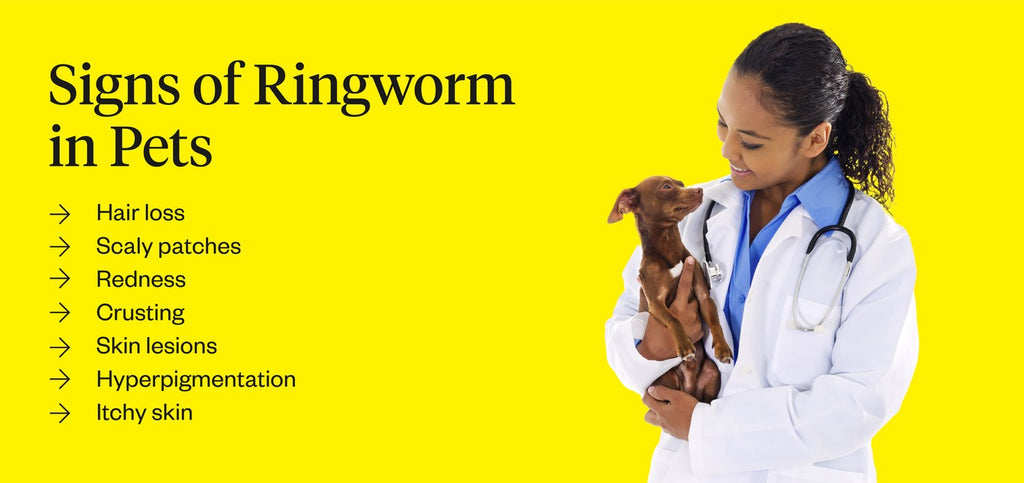Ringworm on a dog appears as circular patches of hair loss, red lesions, scaling, and inflamed skin. These symptoms can be found on the head, chest, forelegs, and back ridge of the dog.
Ringworm is a fungal infection that causes hair loss and skin irritation. It typically manifests as red, circular patches with scaling and crusting. If left untreated, ringworm can spread to other pets and humans. Fortunately, it can be effectively treated with a combination of topical and systemic therapies.
It’s crucial to eliminate all sources of contamination to prevent re-infection. Understanding the signs and treatment options for ringworm in dogs is essential for maintaining your pet’s health and preventing the spread of the infection.
Introduction To Ringworm In Dogs
Ringworm in dogs appears as circular patches of hair loss on the head, tail, or back. Other symptoms include dandruff-like scaling, red lesions on the skin, and crusting or thickening of the skin. Treatment involves a combination of topical and systemic therapy and eliminating environmental contamination.
It is important to note that ringworm is contagious to humans, especially those with broken skin or skin conditions.
Common Misconceptions About Ringworm
Ringworm’s Impact On Canine Health
Identifying Ringworm Symptoms
Ringworm is a common fungal infection that can affect dogs, and it’s important for pet owners to be able to identify the symptoms. Here are some key signs to look out for:
Circular Patterns Of Hair Loss
Dogs with ringworm often develop circular areas of hair loss on their head, tail, or the ridge of their back. These patches may appear red, scaly, or inflamed, and the surrounding hair may be brittle or broken.
Skin Changes And Rashes
In addition to hair loss, ringworm can cause other skin changes such as dandruff-like scaling in the depths of the coat, red lesions on the head, chest, forelegs, and the ridge of the back, as well as scaling, crusting, thickening, and reddening of the skin.
Behavioral Signs Of Discomfort
Dogs with ringworm may exhibit signs of discomfort such as excessive scratching, licking, or chewing at the affected areas. They may also be restless or irritable due to the itching and irritation caused by the infection.
Visual Signs Of Ringworm
When it comes to identifying ringworm on a dog, visual signs play a crucial role in early detection and treatment. Knowing what ringworm looks like on a dog can help pet owners take the necessary steps to address this fungal infection promptly. Here are the visual signs of ringworm in dogs:
Characteristic Lesions
Ringworm characteristically appears in a circular or ring-shaped pattern on the skin, usually causing the skin to turn red, lose hair, and swell. This distinctive lesion is a key visual indicator of ringworm infection in dogs.
Brittle And Broken Hairs
One of the visual signs of ringworm in dogs is the presence of brittle and broken hairs in the affected areas. This is often accompanied by circular patches of hair loss on the head, tail, or the ridge of the dog’s back, further indicating the presence of ringworm.
Dandruff-like Scaling
Dogs with ringworm may exhibit dandruff-like scaling in the depths of their coat. This scaling can be a visual cue to the presence of ringworm and should prompt further examination and possible treatment.
Differentiating Ringworm From Other Conditions
When observing skin issues on your dog, it’s crucial to distinguish ringworm from other conditions to ensure the appropriate treatment. Here are some key factors to consider.
Bacterial Versus Fungal Infections
Bacterial skin infections are often characterized by redness, swelling, and the presence of pus-filled lesions. In contrast, fungal infections such as ringworm typically manifest as circular patches of hair loss with a red, scaly border. These distinctive features can help differentiate between the two types of infections.
Allergies And Their Symptoms
Allergies in dogs can exhibit symptoms such as itching, redness, and skin irritation. While these symptoms can sometimes bear resemblance to those of ringworm, it’s important to note that allergies do not typically cause circular patches of hair loss. Furthermore, allergies may also lead to ear infections and gastrointestinal issues, which are not commonly associated with ringworm.
Treatment Options For Ringworm
Topical Therapies
Topical therapies are commonly used to treat ringworm in dogs. These may include antifungal creams, ointments, or shampoos that are directly applied to the affected areas of the dog’s skin. These topical treatments help to eliminate the fungal infection and promote healing of the skin.
Systemic Medication Approaches
Systemic medication approaches involve the administration of oral antifungal drugs to combat ringworm in dogs. These medications work from within the dog’s body to target the fungal infection systemically, providing a more comprehensive treatment approach.
Environmental Decontamination
Environmental decontamination is a crucial aspect of treating ringworm in dogs. This involves thoroughly cleaning and disinfecting the dog’s living environment to remove any fungal spores that may be present. Regular cleaning of bedding, toys, and other items the dog comes into contact with can help prevent re-infection.

Credit: www.kayanimalhosp.com
Ringworm Transmission Risks
Ringworm is a highly contagious fungal infection that can affect dogs and humans alike. Understanding the transmission risks associated with ringworm is crucial for preventing its spread and safeguarding the well-being of both pets and their human family members.
Contagion Between Dogs And Humans
Ringworm can easily spread from infected dogs to humans through direct contact with the fungal spores present on the dog’s skin or hair. These spores can also be shed into the environment, contaminating surfaces and leading to potential transmission to humans.
Safeguarding Human Family Members
To minimize the risk of ringworm transmission to human family members, it’s essential to practice good hygiene and take proactive measures to prevent exposure. This includes frequent handwashing after handling pets, thorough cleaning of pet living areas, and prompt treatment of any signs of ringworm in pets to prevent its spread within the household.
Preventing Ringworm In Dogs
Preventing ringworm in dogs is crucial for their overall health and well-being. By taking proactive measures, pet owners can significantly reduce the risk of their dogs contracting this fungal infection. Below are some essential strategies for preventing ringworm in dogs:
Environmental Hygiene
Ensuring a clean and hygienic environment is paramount in preventing ringworm in dogs. Regularly cleaning and disinfecting the living space of the dog, including their bedding, toys, and other items they frequently come into contact with, can help minimize the risk of exposure to the ringworm fungus.
Regular Health Check-ups
Scheduling regular health check-ups with a veterinarian is essential for preventing ringworm in dogs. Vets can conduct thorough examinations to detect any signs of ringworm early on, allowing for prompt treatment and minimizing the spread of the infection.
Best Practices For Pet Care
Implementing best practices for pet care is crucial for preventing ringworm in dogs. This includes maintaining a healthy diet, providing regular grooming, and promptly addressing any skin issues or abnormalities. Additionally, avoiding contact with stray animals and ensuring that any new pets introduced to the household are free from ringworm can help prevent the spread of the infection.

Credit: www.reddit.com
Conclusion: Vigilance And Care
Vigilance and care are crucial when identifying ringworm on a dog. Look for circular areas of hair loss, itchiness, skin scabs, and inflamed areas that may indicate this fungal infection. Regular monitoring and prompt treatment are key to managing ringworm in dogs effectively.
Importance Of Early Detection
Detecting ringworm in dogs early is crucial for effective treatment and preventing further spread.
Maintaining A Healthy Environment For Pets
Creating a clean and hygienic living space for pets is essential in preventing ringworm outbreaks.

Credit: www.dutch.com
Frequently Asked Questions
How Do I Tell If My Dog Has Ringworm?
To tell if your dog has ringworm, look for dandruff-like scaling, red lesions, and circular patches of hair loss on their skin.
What Is Mistaken For Ringworm In Dogs?
Bacterial skin infections, skin yeast infections, and allergies are commonly mistaken for ringworm in dogs.
How Do You Treat Ringworm On A Dog?
To treat ringworm on a dog, use a combination of topical therapy and systemic therapy. Eliminate all environmental contamination for successful treatment.
How Contagious Is Ringworm From Dog To Human?
Ringworm is highly contagious from dogs to humans through direct contact. People with scratches, wounds, or skin conditions like eczema are more susceptible to infection. Symptoms in dogs include circular patches of hair loss, scaling, crusting, and reddening of the skin.
Treatment involves a combination of topical and systemic therapies, and environmental decontamination is crucial for successful management.
Conclusion
Recognizing ringworm in dogs involves identifying circular hair loss, red lesions, and skin scaling. Treatment typically includes topical and systemic therapy to eliminate the infection effectively. Remember, prompt detection and treatment are key to managing ringworm in your furry companion.


